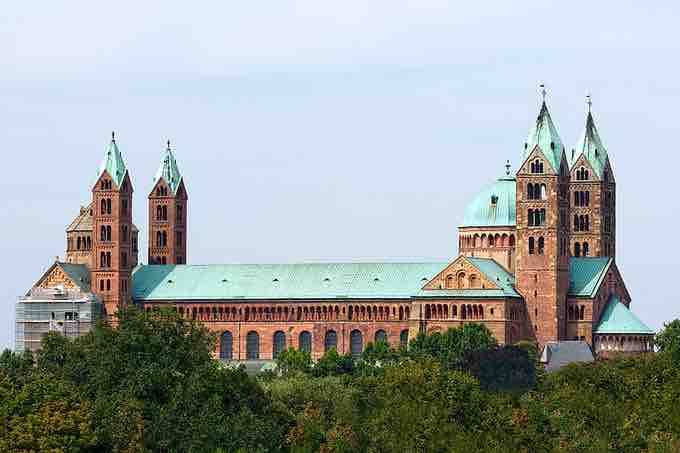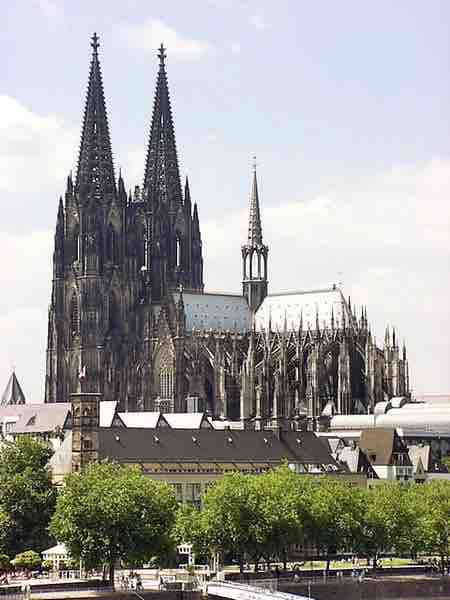Background: The Holy Roman Empire
The Holy Roman Empire was a varying complex of lands that existed from 962 to 1806 in Central Europe. The empire's territory lay predominantly in Central Europe and at its peak included territories of the Kingdoms of Germany, Bohemia, Italy, and Burgundy. For much of its history, the Empire consisted of hundreds of smaller sub-units, principalities, duchies, counties, Free Imperial Cities, and other domains.
Architecture of the Holy Roman Empire
Pre-Romanesque
The Pre-Romanesque period in Western European art is often dated from the Carolingian Renaissance in the late 8th century to the beginning of the 11th century Romanesque period. German buildings from this period include Lorsch Abbey, which combines elements of the Roman triumphal arch (including arch-shaped passageways and half-columns) with the vernacular Teutonic heritage (including baseless triangles of the blind arcade and polychromatic masonry). One of the most important churches in this style is the Abbey Church of St. Michael's, constructed between 1001 and 1031 as the chapel of the Benedictine monastery. It was built in the so-called Ottonic (Early-Romanesque) style during the Ottonian Renaissance.
Romanesque
The Romanesque period (10th - early 13th century) is characterized by semi-circular arches, robust appearance, small paired windows, and groin vaults. Many churches in Germany date from this time, including the twelve Romanesque churches of Cologne. The most significant building of this period in Germany is Speyer Cathedral. It was built in stages from about 1030; in the 11th century, it was the largest building in the Christian world and an architectural symbol of the power of the Salian dynasty, a dynasty of four German Kings that ruled from 1024–1125. Other important examples of Romanesque styles include the cathedrals of Worms and Mainz, Limburg Cathedral (in the Rhenish Romanesque style), Maulbronn Abbey (an example of Cistercian architecture), and the famous castle of Wartburg, which was later expanded in the Gothic style.

Speyer Cathedral, Image by Alfred Hutter
Speyer Cathedral was built during the Romanesque era; in the 11th century, it was the largest building in the Christian world and an architectural symbol of the power of the Salian dynasty.
Gothic
Gothic architecture flourished during the high and late medieval period, evolving from Romanesque architecture. Freiburg Cathedral is noted for its 116-meter tower, which is nearly square at the base, and at its center is the dodecagonal star gallery. Above this gallery, the tower is octagonal and tapered, with the spire above. Cologne Cathedral is—after Milan Cathedral—the largest Gothic cathedral in the world. Construction began in 1248 and took, with interruptions, until 1880 to complete—a period of over 600 years. Because of its enormous twin spires, it also has the largest façade of any church in the world, and its choir boasts the largest height to width ratio of any Medieval church.

Cologne Cathedral
Cologne Cathedral is—after Milan Cathedral—the largest Gothic cathedral in the world, built over a process of 600 years.
Brick Gothic is a specific style of Gothic architecture common in Northern Europe, especially in Northern Germany and the regions around the Baltic Sea without natural rock resources. The buildings are built more or less using only bricks. Stralsund City Hall and St. Nicholas Church are good examples of this style. Cities such as Lübeck, Rostock, Wismar, Stralsund, and Greifswald are shaped by this regional style.
The dwellings of this period were mainly timber-framed buildings, as can still be seen in Goslar and Quedlinburg, the latter of which has one of the oldest half-timbered houses in Germany. The method of construction, used extensively for town houses of the Medieval and Renaissance periods, lasted into the 20th century for rural buildings.
Renaissance
Renaissance architecture (early 15th - early 17th centuries) flourished in different parts of Europe, when there was a conscious revival and development of ancient Greek and Roman thought and culture. As in other areas of Europe, Renaissance architecture in the Holy Roman Empire placed emphasis on symmetry, proportion, geometry, and the regularity of parts as they are demonstrated in the architecture of classical antiquity and, in particular, ancient Roman architecture. Orderly arrangements of columns, pilasters, and lintels, as well as the use of semicircular arches, hemispherical domes, niches, and aedicules, replaced the more complex proportional systems and irregular profiles of medieval buildings. The earliest example of Renaissance architecture in Germany is the Fugger chapel in St. Anne's Church, Augsburg; other works include St. Michael in Munich, Heidelberg Castle, Augsburg City Hall, and castles and manors throughout Wester, Thuringia and Saxony.
Baroque
Baroque architecture began in the early 17th century in Italy and arrived in Germany after the Thirty Years War. The interaction of architecture, painting, and sculpture is an essential feature of Baroque architecture, which integrated new fashions to express the triumph of the Catholic Church and was characterized by new explorations of form, light and shadow, and dramatic intensity. Zwinger Palace in Dresden illustrated the architecture of absolutism, which always put the ruler at the center, thus increasing the spatial composition; for example, a magnificent staircase leading to the person of the ruler. Rococo is the late phase of the Baroque, in which the decoration became even more abundant and showed most colors in even brighter tones. Other examples of Baroque church architecture include the Basilica of the Vierzehnheiligen in Upper Franconia and the rebuilt Frauenkirche in Dresden.

Die Frauenkirche in Dresden
The rebuilt Frauenkirche in Dresden was created by George Bähr between 1722 and 1743, and is an example of Baroque architecture in Germany.
Classicism
Classicism arrived in Germany in the second half of the 18th century. It drew inspiration from the classical architecture of antiquity and was a reaction against the Baroque style, in both architecture and landscape design. The most important architect of this style in Germany was undoubtedly Karl Friedrich Schinkel. Schinkel's style, in his most productive period, is defined by its appeal to Greek rather than Imperial Roman architecture; his most famous buildings are found in and around Berlin.